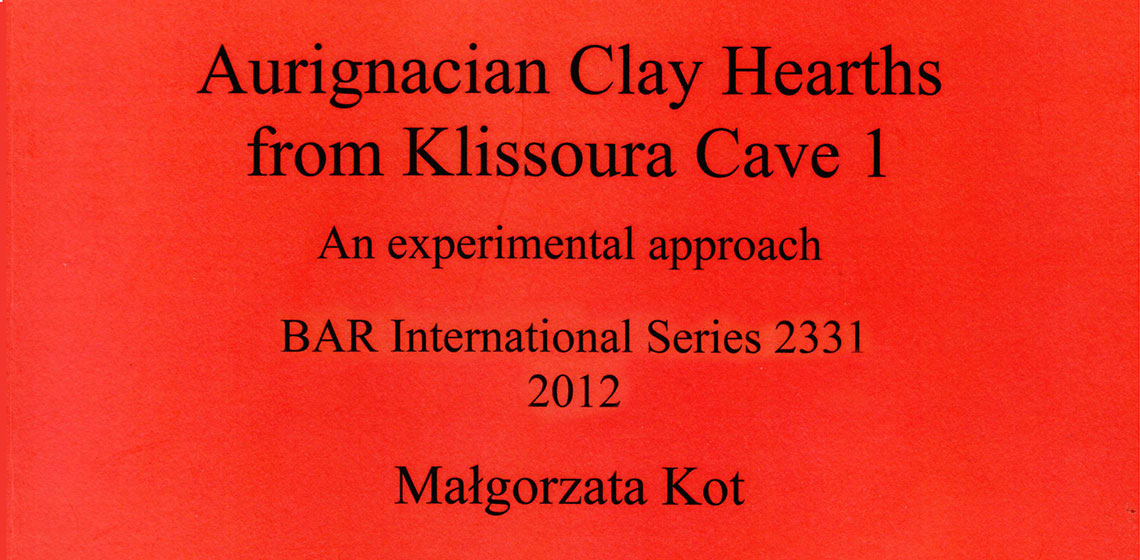
About 90 concave, clay-lined hearths were identified during excavations of Aurignacian layers (ca. 35000BC in Klissoura Cave 1, Greece (e.g., Karkanas et al. 2004; Koumouzelis et al. 2001). Only two similar combustion features, identified at the Czech site Dolni Věstonice and defined as kilns (Vandiver et al. 1989), were known from Palaeolithic contexts before the excavations at Klissoura...
The features at Klissoura are thus important to the understanding of variations in fire-related behaviour during the Palaeolithic and the beginning of clay use and firing. In her book, Kot describes and discusses 33 experiments conducted to examine the use of these clay-lined hearths. This aim is based on the premise that these features were built for special purposes and on suggestions of use from other researchers, including using hearths for roasting wild grass seeds (Karkanas et al. 2004).
Kot conducted her experiments in Poland, Germany, Romania and Greece, used different types of clay in the experimental hearths and tested four different firing methods (dry or wet clay heated by embers or direct fire). Some of the experiments included multiple fires in the same feature, while some involved roasting nuts or seeds. The temperature at different points in the hearth was recorded every 15 minutes in some of the experiments using dataloggers and thermocouples. Kot demonstrates in her experiments the thermal properties of clay-lined hearths, including a slow heating rate and the ability to retain heat. Colour changes in clay as a result of heat exposure are documented by this work, but only one of the experiments matches the archaeological samples. Kot also shows that clay-lined hearths can be used to store embers for a long time. Lastly, the experiments imply that boiling water in these features or placing food or other objects on the clay surface requires they be swept of ashes, which is not consistent with the archaeological clay-lined hearths.
The general structure of this book is good. The experiments are presented chronologically, which allows the reader to follow the development of ideas, questions and methods through the project. However, the text contains quite a few spelling errors and poorly constructed sentences, which sometimes makes it difficult to understand the author. The schematic drawings (e.g., Figure 4.1) help the reader to follow the workflow of the experiments. In addition, there are pictures of some of the experimental clay-lined hearths on the last three pages of the book. Other illustrations, such as photos taken during the experimental fires and section drawings of experimental hearths described in the text, would also have been of great benefit to the reader, and should be considered for future publications.
Kot opens her book with a brief introduction to Klissoura and her project, along with a short description of the clay-lined hearths. She refers the reader to central publications of the site for more information, but a more thorough and detailed description of the site, the features, interpretations and previous relevant experiments would have provided a better background for her experiments. Descriptions of the experiments form the main part of the book. Several variables differ in the experiments. For example, Kot uses different types of clay, temperatures are not recorded in some of her experiments and the experimental hearths have different sizes and depths. This makes it difficult to compare the results. Nevertheless, the detailed description of each experiment makes them easy to replicate. The thorough presentation also provides insight into the creativity and flexibility needed to solve the unexpected events or circumstances that can occur in any experiment, such as difficulties in sampling because of the hardness of the clay (for example, experiment p1KII, p. 15) or problems with thermocouples (for example, experiment p1KIV, p. 29). Unfortunately, the chapters with results and conclusions are very short and do not provide a detailed discussion of all the questions raised and results achieved.
The experimental design and the thorough descriptions of experiments in this book are interesting to those who, like me, conduct their own fire experiments. Furthermore, Kot's honest descriptions of both problems occurring during the experiments and their solutions provide valuable insight for people with little experimental experience. You might also enjoy this book if you are interested in early cooking techniques and the origins of clay firing.
Book information:
KOT, Małgorzata, 2012. Aurignacian Clay Hearths from Klissoura Cave 1: an Experimental Approach, BAR International Series 2331, Oxford: British Archaeological Reports, ISBN: 978-1407309149.

Bibliography
KARKANAS, P., KOUMOUZELIS, M., KOZLOWKSI, J.K., SITLIVY, V., SOBCZYK, K., BERNA, F. and WEINER, S., 2004. Aurignacian clay hearth structures in Kleisoura cave 1, southern Greece: the earliest evidence of clay use. Antiquity 78, pp.513–525.
KOUMOUZELIS, M., GINTER, B., KOZLOWSKI, J.K., PAWLIKOWSKI, M., BAR-YOSEF, O., ALBERT, R.M., LITYNSKA-ZAJAC, M., STWORZEWICZ, E., WOJTAL, P., LIPECKI, G., TOMEK, T., BOCHENSKI, Z.M. and PAZDUR, A., 2001. The Early Upper Palaeolithic in Greece: The Excavations in Klisoura Cave. J. Archaeol. Sci. 28, pp.515–539.
VANDIVER, P.B., SOFFER, O., KLIMA, B. and SVOBODA, J., 1989. The Origins of Ceramic Technology at Dolni Věstonice, Czechoslovakia. Science 246, pp.1002–1008.